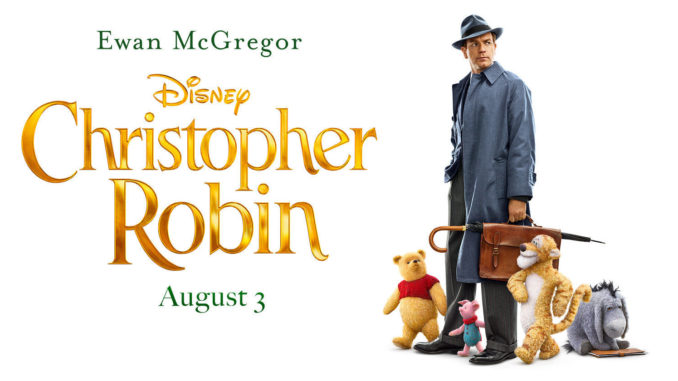
Winnie the Pooh has enriched the hearts and minds of children ever since its initial release as a children’s novel by British author A.A. Milne back in 1926. Since then, Winnie and his friends Piglet, Tigger, and the rest of the 100 Acre Wood gang have been uprooted into the global lexicon.
Everyone knows at least the basic elements of this famed short story. From illustrated novels to toys and even cartoons, Winnie and the gang have received more notoriety than any other cartoon character with the exception of Mickey Mouse. But with the current trend in cinema to reboot already established franchises, Christopher Robin is born into global cinemas now in 2018. Released by Disney Productions under the directorship of Marc Forster, Christopher Robin is a retelling of the original Winnie the Pooh novel set in the adult life of the film’s titular character during of post-war London. With Ewan McGregor in the lead role and a voice-over cast featuring the likes of Jim Cummings and Brad Garrett, this modern remake seemed destined for box office greatness. But unfortunately, as with most other rehashing’s, the original is best left untainted.
The Plot
Christopher Robin is all grown up and the film follows his development from innocent child roaming the secret world of the 100 Acre Woods to his service in the British military during World War 2, and the eventual birth of his daughter. Haley Atwell delivers a stunning performance as Evelyn Robin, the unhappy wife of Christopher who wishes her husband to leave his job as a luggage manufacturer and spend more time at home with their daughter, Madeline (Bronte Carmichael). As the struggle between his work and personal life escalates, Christopher is eventually reunited with his long-forgotten friend Winnie in a small park in central London. It takes a while for Christopher to cope with the antics of the wily woodland bear in real-world England. Eventually, Christopher reunites with all his forgotten friends, and the gap between fantasy and reality is bridged once Winnie and his gang enter the gritty streets of 1940s London.
Through this reconnect between the adult Christopher Robin and his inner child, the titular character is able to mend the rift within his family while at the same time overcome the anguish of his mundane job. Similarly, Christopher Robin amends the insanity that was his childhood by accepting the fantastical world of Pooh and exposing his family to this once secret landscape. Both simple and predictable, the plot of Christopher Robin became the main focus of its criticism and the reason why this film is just short of what could have been a brilliant way of introducing a new generation to this beloved children’s book.
The Cons
As previously mentioned, the plot of Christopher Robin is where the film comes into some trouble. Using a three-act structure, the screenwriters (Alex Ross Perry and Allison Schroeder) failed to create any sense of climax and ensuing resolution during its final moments. Christopher’s fainting marriage is not believable in terms of the way it was written and the script lacked a depth of subtext throughout. Every protagonist needs a conflict to create a sense of resolution by a script’s final act, and Christopher Robin failed to adhere to this one main rule in Screenwriting. The internal conflict of Ewan McGregor’s character did not resonate as it should have when one analyzes the triangular set up of struggles between the inner self, work life, and family. Certainly, this a film geared towards a more childish audience, but Forster failed to connect the audience to the hardships of Robin’s current predicament.  The early 90’s masterpiece, Hook, is the prime example of dealing with children’s material in a more mature manner. A director can provide a deep-lying subtext even to an adolescent work by tailoring a script to the vision of a wider audience. Forster failed to do so in this instance, and the plot suffered greatly for it.
But other than a shoddy plot and weak screenplay, Christopher Robin failed in one other key department and that is the world of Winnie the Pooh. 100-Acre Wood is barely ventured through and its fantastical setting a side not when compared to the landscape of real-world England. Granted the filmmaker chose a storybook frame that tells the world of Pooh in chapter format. A simple animated sequence describes the world of Winnie’s world and that is really about all we see of it. The second act of the script when Robin enters Pooh’s world and seeing Eyeore and Piglet again is brief and almost useless when one considers the amount of time the filmmaker spends on the antics of these woodland creatures in London. A misstep surely, considering the variation in landscapes the 100-Acre Woods has in the storybooks and animated films. As a viewer, one can see where the focus of the plot was and that is on the lackluster Christopher Robin and his troubles rather than the breathtaking otherworldly feel of Winnie’s lush land. Thus, these two fundamental mishaps in the script and plot hampered what otherwise could have been a brilliant Disney production. But the film still had some bright spots that make it worth seeing.
The Pros
Besides an underwhelming screenplay and some bizarre directing choices, Christopher Robin is still a wonderful film to behold. A brilliant cast led by Ewan McGregor made every scene feel like a Shakespearean play. The voice acting itself is on a whole new level that would give Jim Henson a run for his money. Brad Garrett displays an amazing performance as the melancholic Eyeore and that one seen when he and Piglet and Tigger are stuck in a trunk on the back of a car brilliants evokes the contrasting personalities of these characters. Eyeore’s humdrum approach to life is a counterpoint to the tough as nails attitude of Tigger.
Jim Cummings, who voices both Tigger and Winnie, gives an astonishing masterclass in voice acting as he stunningly switches vocal styles to adjust to the personality traits of the two characters. If anything this film proves that occasionally a poor script can be overcome by the brilliance of its cast and every frame of Christopher Robin is evidence of that.
The production values were extraordinary in this film as the live action sequences between Christopher Robin and Winnie are a sight to behold. Choosing to film in the Ashdown Forest during the 100 Acre Woods segments proved to better the visual elements of Forster’s production, as A.A. Milne was said to be inspired by its landscape. The use of real-world location shooting instead of a studio lends the film an organic feel that gives breath to every shot. This cinematic choice also accentuated the live action sequences even further by placing unrealistic characters in a reality-based world, thus giving the fantastical a sense of truth.
Disney never fails when producing high-quality entertainment and Christopher Robin is yet another film in their canon that embodies the values of this storied company. The musical score is wonderfully orchestrated by Geoff Zanelli whose work has been featured in other high profile film franchises such as Shark Tale. Zanelli’s score comes masterfully into effect during the opening sequence when a young Christopher Robin bids farewell to his friends in the 100 Acre Woods as he must go to a rigid boarding school at the behest of his father. Such an eloquent orchestral score during those touching moments created an emotional attachment between Robin and his friends that only a master of the musical craft can evoke.
But high production values, flashy visuals, and an amazing soundtrack were not enough to keep this film from sinking in the sea of mediocrity.
The Verdict
In the end, Christopher Robin is at best a film one should stream on a Saturday night when you have nothing else to do. Such popular entertainment fares well in the box office and on Netflix, but truth sets another litmus test that money simply cannot overcome. The main character failed to enlighten the audience to his inner and outward conflicts. The time spent on exploring the land of the 100 Acre Woods felt more like a glimpse rather than a full-fledged romp. Even the choice of spotlighted characters was poorly executed as the Owl, voiced by Toby Jones, received little to no film time. These were decisions that a director has to make from the outset and unfortunately Forster’s instincts served to undermine everything a reboot hopes to achieve.
The world of Winnie the Pooh is vast and vibrant. Milner’s work in the 1920’s had more depth of scale than this film has in 2018. But yet I could not help enjoy some of the sequences that resonated during the third act of the screenplay. Much like a bar or a club, the fun experienced in this film is vain at best. A lack of subtext and plot points permeated throughout the film’s runtime and merely a few highlights stood out.


Leave a Reply